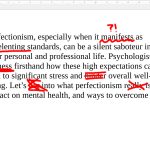Trauma often leads to mental health problems, such as vivid and distressing memories of the event, avoiding anything related to it, anxiety, being on edge or other signs of heightened alertness. Some people end up reliving their trauma repeatedly, a phenomenon referred to as trauma reenactments.
Table of Contents
What is an example of trauma reenactment?
An example of trauma reenactment, based on research, is that women who were abused as children are more likely to experience abuse in their adult relationships.
Another example is seeking out toxic or abusive romantic relationship as an adult after experiencing psychological abuse from parents in childhood.
What is creating trauma reenactments?
There are different theories about why reenactments happen. Some argue that this is a spontaneous replay of past traumatic events that were never talked about or even remembered. Instead of expressing feelings with words, people act them out physically.
Sigmund Freud suggested that people who can’t remember traumatic events may end up repeating them in the present because they haven’t processed them as memories from the past.
Others believe reenactments occur due to the psychological vulnerabilities common in trauma survivors, making them easy targets for further victimisation.
Some see reenactments as a way for individuals to gain control and mastery over their trauma, by reliving it to remember, process, and heal.
While reenactments might seem like deliberate choices from the outside, there’s a sense of them happening involuntarily. Even though some believe that reenacting a past trauma helps to gain control over it, the reality is that lifelong reenactments rarely lead to resolution. Seeking help from a psychologist is essential.
Four categories of trauma reenactment
Breaking down reenactments into four general categories can help to understand why traumatised individuals struggle to gain mastery and guide clinical intervention.
In the first category, individuals actively reenact past traumatic situations in an attempt to gain control. Some of these efforts are helpful, while others can lead to ongoing victimisation and difficulties.
The other three types of reenactments happen more unintentionally. In cases of rigidified defences, the defences themselves lead to reenactments and the problems they were meant to avoid.
Emotion dysregulation and cognitive reactions can trigger reenactments when intense emotional and cognitive responses get mirrored by others, leading to repetition.
Lastly, ego deficits in trauma survivors can make them vulnerable to reenactments and further victimisation. While this classification may seem a bit artificial, as elements from different categories often play a role together, it helps illustrate the various ways reenactments can unfold.
Trying to gain control
Sometimes, people actively replay parts of a past traumatic experience as a way to deal with it and gain control. This attempt to cope and master the trauma can go in two directions. In some cases, it’s a helpful process that leads to successfully resolving and working through the earlier trauma. But in other situations, trying to master the trauma becomes a problem, causing ongoing distress and difficulties.
It’s not always easy to tell the difference between a helpful coping mechanism and a harmful one because all coping strategies involve inner struggles to adapt to life’s challenges.
Regaining partial control
Trauma can affect different aspects of a person’s life, and someone might successfully cope with certain aspects of the trauma (career) while struggling in other areas (personal life). For instance, someone who endured severe childhood beatings can later become a homicide detective, driven by a relentless pursuit of injustice and crime. Despite excelling in their career, personal relationships can be marked by competitiveness, detachment, and an underlying sense of fear.
Adaptive coping of trauma – being present
Adaptive responses to traumatic events are different from unhelpful ones. They involve a more flexible coping style, are focused on the present and future rather than the past, and make use of clear thinking processes. Unlike maladaptive responses, adaptive ones make emotions from the past less overwhelming and destabilising. They also lead to changes in negative beliefs about oneself and others. These changes help a person to respond to the present without being confined by past experiences.
Replaying traumatic memories
Actively replaying a past traumatic experience might be a way for someone to deal with the intense emotions and beliefs tied to that original trauma. According to Freud, repeating memories that felt uncontrollable and unpleasant at the time could be a path to mastery. By reliving it, the person gradually regains a sense of control over what was once endured.
For instance, a woman who was sexually abused as a child and developed a fear of physical contact can sign up for massage therapy training. By putting herself in a situation reminiscent of her past trauma and discussing her experiences in therapy, she can work through the overwhelming emotions connected to her abuse and lessen her fear of physical touch.
What is repetition compulsion?
Therapy plays a crucial role in helping individuals effectively process and master past traumas. Going back to the detective who coped with childhood abuse by becoming a detective and intentionally taking on risky situations, therapy can help him to gain insights into his decision-making, reducing his repetition compulsion – the need to engage in physically risky situations.
When replaying trauma is maladaptive
Actively replaying a past trauma can be a sign of maladaptive defence. For instance, individuals who were victims of childhood sexual abuse may become abusers themselves in adult relationships. In these cases, reenacting the abuse becomes a way to avoid reliving the fear and helplessness tied to the original traumatic experience. The abusive behaviour also allows them to express and direct their rage towards others. While this may seem like an attempt to master the past trauma, it is maladaptive because it does not lead to a reworking and integration of the traumatic history, and it victimises others in the process.
Childhood sexual abuse has also been connected to adult prostitution in some cases. Women who engage in prostitution choose prostitution to control men through sex and take active control after being passively victimised before. However, this does not make it an adaptive resolution. Similarly to the previous example, even if the person feels in control, old patterns of past relationships are still playing out.
Toxic relationships that feel familiar
People who have experienced trauma might unconsciously seek out relationships similar to past abusive ones because there’s comfort in familiarity. For example, a man emotionally abused by his mother might end up with a woman who has similar traits. The high arousal state from past traumatic relationships leads them to repeat destructive patterns from the past.

Maladaptive reenactments can also happen when someone seeks out a powerful, caretaking, but sometimes abusive partner, to help with their fragile sense of self. Survivors of childhood psychological abuse who harbour self-hatred and a belief that they deserve mistreatment may gravitate towards others who resonate with this negative self-concept, repeating past experiences.
Inflexible self-defences leading to unintentional reenactments
Sometimes, people unknowingly repeat elements of their past traumatic experiences due to relying on inflexible ways of protecting themselves. Adults who endure childhood trauma often live in constant fear of those traumatic feelings returning. To avoid these fears, people may develop rigid ways of behaving and thinking. Unfortunately, these inflexible defences can end up causing the very problems they were meant to prevent.
For example, a man who experienced abandonment from his mother as a child may develop an intense fear of being left again. In an attempt to prevent further abandonment, he formed possessive and clingy relationships with women. However, his suffocating behaviour led to the exact thing he feared – women leaving him, resulting in the pain of abandonment happening repeatedly.
Conversely, a woman who had a rejecting relationship with her father may cope with her fear of being rejected again by getting involved with people she does not love. Even though these individuals did not fulfil her emotional needs, which mirrored her past relationship with her father, she avoided her greatest fear – being rejected by someone she genuinely cared about. In these examples, the efforts to escape overwhelming traumatic feelings lead to decisions that cause reenactments they were trying to avoid.
Other’s Reactions to intense feelings of trauma
Another way reenactments happen is when someone expresses intense feelings from the past, and others react to it. A woman who was physically abused as a child is likely to carry a lot of anger from that time and is likely very sensitive to criticism. In adult relationships, any criticism would make her overreact, unleashing her rage in hostile ways. This not only leads to frequent fights but may also escalate into physical abuse, putting her back in a situation similar to her past.
It is important to understand that reenactments are not a means to blame trauma survivors: there’s no excuse for abusing others. These examples merely illustrate that in specific situations, reenactment can happen when unresolved feelings and beliefs from past trauma resurface in the present.
Mental health problems linked to trauma
Childhood trauma often has lasting effects on mental well-being, including depression, low self-esteem, drug and alcohol use, self-harm, anxiety, learning difficulties, relationship problems, identity issues, and a sense of helplessness.
Problems with identity and self-concept from early trauma can make individuals seek out others who resonate with and counter these issues. Someone who feels helpless and out of control is often drawn to individuals who can take control and provide a sense of security. This vulnerability can sometimes lead to further victimisation.
Another factor contributing to repeated reenactments is the use of dissociative defences. Trauma survivors might tolerate mistreatment because of their habitual use of this defensive style. While it may help them endure the situation, it simultaneously inhibits appropriate action, allowing past abuse to be re-enacted.
Targeting inflexible behaviours is not the first step in treatment
As ongoing patterns often lead to more victimisation, a goal in therapy is helping the person understand and gain control over these repetitive behaviours.
However, therapy, such as CBT therapy, must start with an establishment of a strong bond with the client and ensure their safety, including resolving urgent issues, like substance use and other self-destructive behaviours.
Once these foundational aspects are in place, the psychologist can guide the person to recognise the dysfunctional patterns. Instead of directly saying “You are reenacting a trauma!“, it might be more effective to highlight a destructive interaction pattern and explore how it unfolds. This approach is closer to the patient’s subjective experience and can be more likely to create change.
The link between early experiences and current behaviours
Once both the client and the therapist understand how the reenactment is unfolding, the next step is to understand why the patient feels and acts that way. This exploration often involves the client’s history of trauma that continues to influence their current feelings and behaviours. Spending time to understand the client’s childhood experiences is essential.
For example, a man seeking help with his intense anger may childhood experience of a physically abusive mother and an emotionally distant father. Therapy can help to understand how his current mistreatment and emotional abuse by his lover, resembling his past relationship with his mother, is triggering his rage. Clients like him often talk about mistreatment by partners with little emotion or even brush it off. With the therapist’s guidance, clients can understand how they used to block off their feelings in childhood to endure their mother’s abuse. They can also learn to attend to and trust feelings as a guide for action, and as a result, they often end relationships that are one-sided, toxic, or abusive.
When early trauma is too much to talk about
For clients who do not have the strength or desire to talk about early traumatisation, therapy can still be beneficial. Even without a complete reworking of past trauma, reenactments can be stopped by helping the person respond differently through behavioural and cognitive changes.
For instance, a woman with a history of childhood sexual abuse can learn to see that he has been abused in many of her adult relationships. However, directly exploring how others took advantage of her might not be productive for therapy. At the same time, the therapist can express their own feelings of wanting to rescue the patient, and this discussion can help the client understand how her timid presentation, and how she perceives herself in the eyes of others, can lead to abusive relationships.
Regardless of the tools used, healing is a gradual process, often taking years.
Please note that this blog post by Personal Psychology in North Sydney is not intended to provide professional advice. If you or someone you know is experiencing mental health difficulties, it is important to seek help from a qualified healthcare professional.





